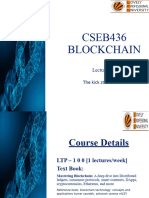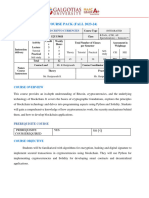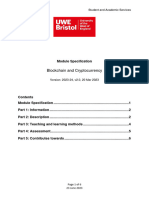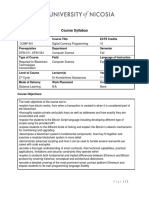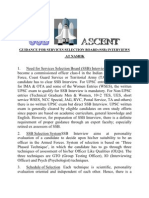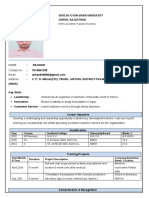Annexure-II 1
Blockchain Technology Semester 6
Course Code BCS613A CIE Marks 50
Teaching Hours/Week (L: T:P: S) 3:0:0:0 SEE Marks 50
Total Hours of Pedagogy 40 Total Marks 100
Credits 03 Exam Hours 03
Examination type (SEE) Theory
Course objectives:
● To Understand Blockchain terminologies with its applications. design
● To learn working principles of Blockchain and methodologies used in Bitcoin
● To gain knowledge on Ethereum Network, Wallets, Nodes, Smart contract & DApps
● To learn blockchain Based Application Architecture using Hyperledger and the Smart
Contract Lifecycle
Teaching-Learning Process (General Instructions)
These are sample Strategies, which teachers can use to accelerate the attainment of the various course
outcomes.
1. Lecturer method (L) needs not to be only a traditional lecture method, but alternative effective
teaching methods could be adopted to attain the outcomes.
2. Use of Video/Animation/Demonstration to explain functioning of various concepts.
3. Encourage collaborative (Group Learning) Learning in the class.
4. Ask at least three HOT (Higher order Thinking) questions in the class, which promotes critical
thinking.
5. Adopt Problem Based Learning (PBL), which fosters students’ Analytical skills, develop design
thinking skills such as the ability to design, evaluate, generalize, and analyze information rather
than simply recall it.
6. Use animations/videos to help the students to understand the concepts.
Module-1
Distributed systems, CAP theorem, Byzantine Generals problem, Consensus. The history of blockchain,
Introduction to blockchain, Various technical definitions of blockchains, Generic elements of a
blockchain, Features of a blockchain, Applications of blockchain technology, Tiers of blockchain
technology, Consensus in blockchain, CAP theorem and blockchain, Benefits and limitations of
blockchain.
Chapter 1
Module-2
Decentralization using blockchain, Methods of decentralization, Blockchain and full ecosystem
decentralization, Smart contract, Decentralized organizations, Decentralized autonomous
organizations, Decentralized autonomous corporations, Decentralized autonomous societies
Decentralized applications, Platforms for decentralization.
Cryptographic primitives: Symmetric cryptography, Asymmetric cryptography, Public and private keys,
Hash functions: Compression of arbitrary messages into fixed length digest, Easy to compute, Pre-image
resistance, Second pre-image resistance, Collision resistance, Message Digest (MD),Secure Hash
Algorithms (SHAs), Merkle trees, Patricia trees, Distributed hash tables (DHTs), Digital signatures,
Elliptic Curve Digital signature algorithm (ECDSA).
Chapter 2, Chapter 3: pg:56-105
Module-3
@#@10012025 1
� Annexure-II 2
Bitcoin, Bitcoin definition, Transactions, The transaction life cycle, The transaction structure,
Types of transaction, The structure of a block , The structure of a block header, The genesis
block, The bitcoin network, Wallets, Smart Contracts-History, Definition, Ricardian contracts,
Smart contract templates, Oracles, Smart Oracles, Deploying smart contracts on a blockchain,
The DAO.
Chapter 4:pg:111-148, Chapter 6
Module-4
Ethereum 101, Introduction, Ethereum clients and releases, The Ethereum stack, Ethereum blockchain,
Currency (ETH and ETC), Forks, Gas, The consensus mechanism, The world state, Transactions, Contract
creation transaction, Message call transaction, Elements of the Ethereum blockchain , Ethereum virtual
machine (EVM), Accounts, Block, Ether, Messages, Mining, The Ethereum network.
Hands-on: Clients and wallets –Geth.
Chapter 7: pg: 210-227, 235-269
Module-5
Hyperledger, Hyperledger as a protocol, Fabric, Hyperledger Fabric, Sawtooth lake, Corda.
Chapter 9
Course outcomes (Course Skill Set)
At the end of the course, the student will be able to :
1. Explain the Blockchain terminologies with its applications. design
2. Illustrate the working principles of Blockchain and the Smart Contract Lifecycle
3. Demonstrate the principles and methodologies used in Bitcoin
4. Develop Ethereum Network, Wallets, Nodes, Smart contract and DApps.
5. Make use of Hyperledger in Blockchain Based Application Architecture.
@#@10012025 2
� Annexure-II 3
Assessment Details (both CIE and SEE)
The weightage of Continuous Internal Evaluation (CIE) is 50% and for Semester End Exam (SEE)
is 50%. The minimum passing mark for the CIE is 40% of the maximum marks (20 marks out of
50) and for the SEE minimum passing mark is 35% of the maximum marks (18 out of 50 marks). A
student shall be deemed to have satisfied the academic requirements and earned the credits
allotted to each subject/ course if the student secures a minimum of 40% (40 marks out of 100) in
the sum total of the CIE (Continuous Internal Evaluation) and SEE (Semester End Examination)
taken together.
Continuous Internal Evaluation:
● For the Assignment component of the CIE, there are 25 marks and for the Internal Assessment
Test component, there are 25 marks.
● The first test will be administered after 40-50% of the syllabus has been covered, and the
second test will be administered after 85-90% of the syllabus has been covered
● Any two assignment methods mentioned in the 22OB2.4, if an assignment is project-based
then only one assignment for the course shall be planned. The teacher should not conduct
two assignments at the end of the semester if two assignments are planned.
● For the course, CIE marks will be based on a scaled-down sum of two tests and other methods
of assessment.
Internal Assessment Test question paper is designed to attain the different levels of Bloom’s
taxonomy as per the outcome defined for the course.
Semester-End Examination:
Theory SEE will be conducted by University as per the scheduled timetable, with common question papers
for the course (duration 03 hours).
1. The question paper will have ten questions. Each question is set for 20 marks.
2. There will be 2 questions from each module. Each of the two questions under a module (with a
maximum of 3 sub-questions), should have a mix of topics under that module.
3. The students have to answer 5 full questions, selecting one full question from each module.
4. Marks scored shall be proportionally reduced to 50 marks.
Suggested Learning Resources:
Books
1. Imran Bashir. “Mastring BlockChain”, Third Edition, Packt – 2020.
Reference Book
1. Andreas M. , Mastering Bitcoin: Programming the Open Blockchain – O’rielly – 2017.
Web links and Video Lectures (e-Resources):
● https://nptel.ac.in/courses/106104220
● https://www.geeksforgeeks.org/blockchain/
● https://www.tutorialspoint.com/blockchain/index.htm
Activity Based Learning (Suggested Activities in Class)/ Practical Based learning
● Course Project: Covers the implementation of the major concepts outlined in the syllabus– 25
Marks
@#@10012025 3




